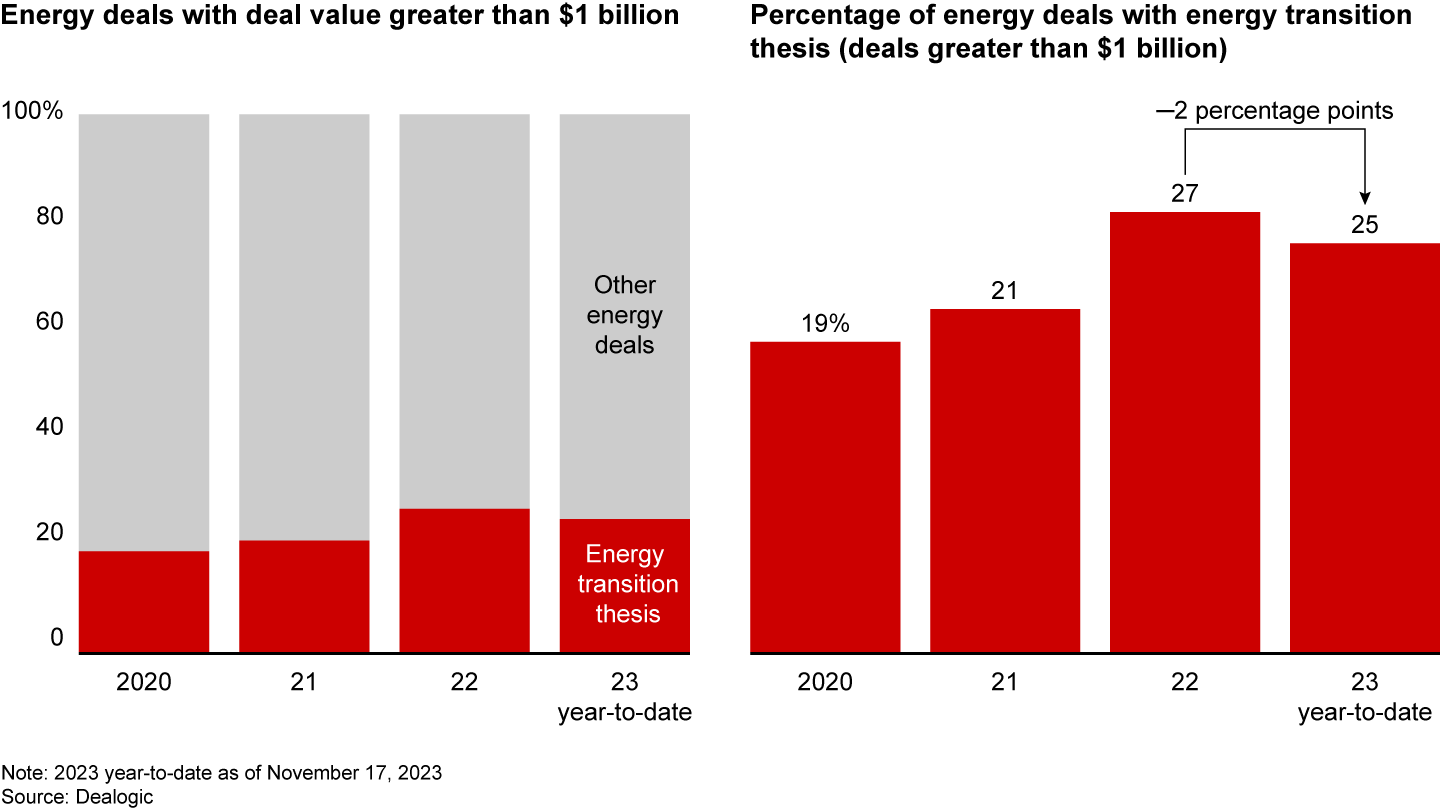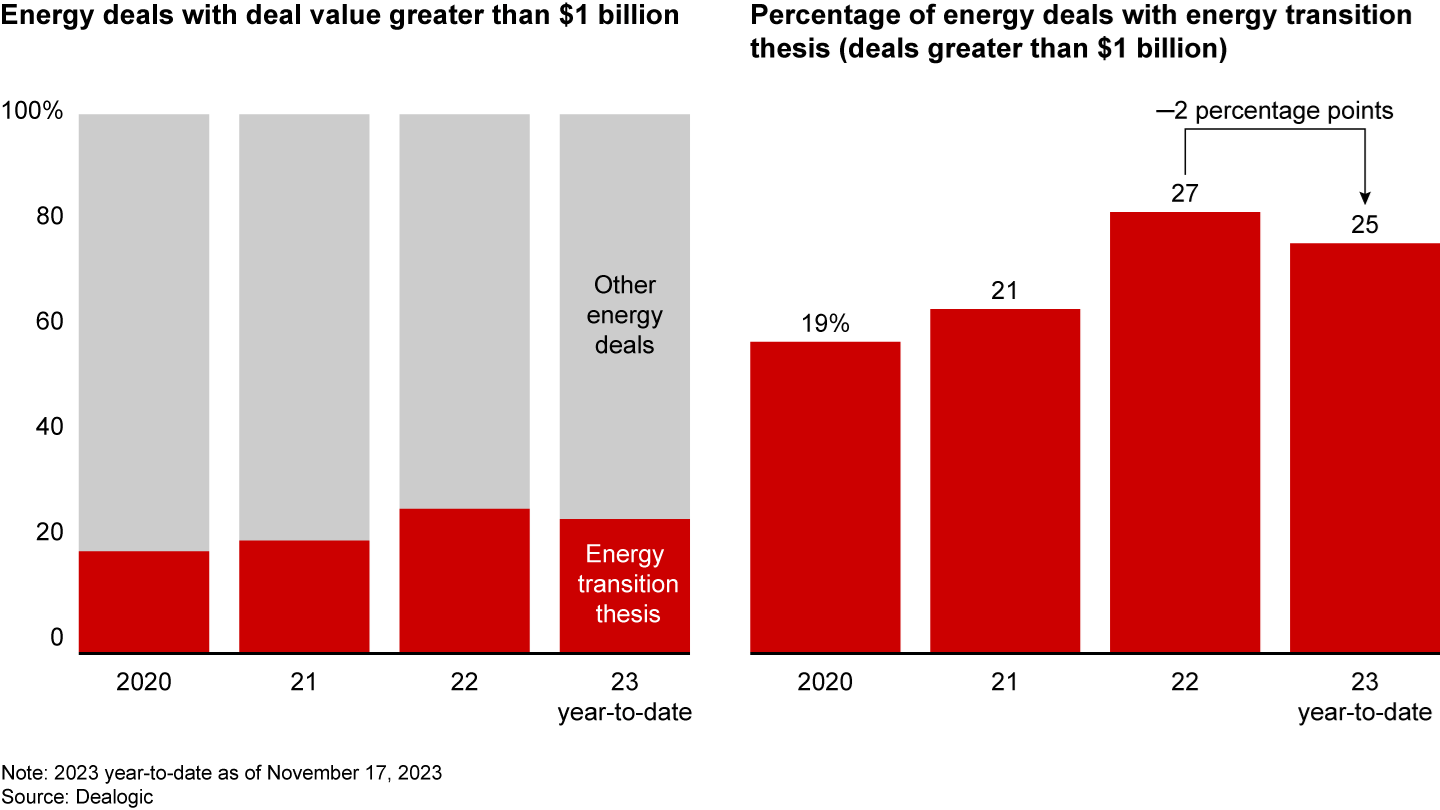M&A Report

At a Glance
- After three years of steady growth, energy transition deals plateaued in the first nine months of 2023.
- Energy and natural resources companies are balancing deals between reinforcing the core businesses and promoting a low-carbon agenda.
- To strike the right balance, the best companies will take a more targeted approach to their energy transition acquisitions.
Este artigo faz parte do Relatório de Fusões e Aquisições de 2023 da Bain.
Companies in the energy and natural resources (ENR) industries face a strategic crossroads. Do they invest and pursue deals to shore up their legacy higher-carbon businesses, where profit pools are potentially poised to decline given the world’s ambition to accelerate to net zero, or do they shift their focus to businesses that deliver on the clean energy transition, where profit pools are growing rapidly from a much smaller base?
That question is at the heart of M&A strategy for all ENR companies, and the year 2023 gave us a glimpse of how they are answering it. After three years of increasing growth, the volume of energy transition deals plateaued (likely temporarily) as companies readjust their priorities and demonstrate that the movement to a lower-carbon future and a circular economy is not linear. That path now appears less straightforward, rockier, and more expensive than it did just a few years ago.
Look at the numbers. In 2020, 19% of M&A total deal volume (for deals in excess of $1 billion) was related to the energy transition, and that number increased to 21% in 2021 and 27% in 2022 before leveling at 25% for the first nine months of 2023 (see Figure 1). We see this as an initial stabilization before continued capital rotation toward the energy transition in the latter part of the decade.


There are several factors influencing this shift.
First, US government subsidies haven’t been enough to fully offset higher interest rates and supply chain costs, and geopolitical tensions are shifting some of the focus to energy security. A number of energy sectors have felt the impact—most prominently, the offshore wind markets. Ørsted had a record $4 billion impairment loss and canceled two high-profile projects in the US, for example.
Also, equity markets have not valued energy transition investments. Valuation multiples for European international oil companies (IOCs) have traded at discounts to their more premium-rated US-based IOC peers. A specific goal for the European IOCs is to narrow and even close the structural valuation gap with US IOCs. Earlier this year, both Shell and BP signaled an intention to lean back into oil and gas, prolonging production. Similarly, market valuations for pure play renewable power companies have fallen, with the iShares Global Clean Energy ETF down 27% in 2023 as of December 1.
A final reason for the shift: Energy transition investments typically involve project financing and modest debt levels, and today’s uncertain macroeconomic backdrop and higher interest rates have made project economics less attractive.
This has made it even more difficult for energy companies to balance the dual challenge of continuing to spur performance in their core hydrocarbon businesses—in safety, productivity, cost, carbon, and capital productivity—while demonstrating that they also are worthy custodians of clean energy capital.
This tension between improving performance in the core hydrocarbon business and advancing the fragmented, disorderly, and nonlinear energy transition can be seen in M&A activity throughout the industry. In oil and gas, ExxonMobil and Chevron recently invested more than $110 billion to acquire Pioneer and Hess, respectively. These are investments in their core businesses and are great examples of how companies are taking decisive action to enhance scale, reinforce the core components of their existing portfolios, ensure that their reserves and resources are abundant and competitive, and beef up their integrated value chains.
But these large acquisitions do not need to be made at the expense of continued strategic investments in the energy transition. For example, ExxonMobil recently purchased lithium drilling rights on 120,000 acres in the US and aims to become a major US supplier for makers of electric vehicle (EV) batteries by 2030. It’s part of ExxonMobil’s long-term effort to reposition itself for the advancement of EVs and electrification in transportation. For its part, Chevron set an ambition to become a leader in renewable fuels by producing 100,000 barrels per day by 2030. It has a focused M&A strategy with two completed acquisitions and one joint venture—deals that advanced Chevron halfway toward that goal.
As they rebalance their M&A strategies to reinforce the core to fuel investments during the energy transition, we see five things that ENR companies can do to improve their odds of success.
- Clarify your business model for the energy transition. When it comes to making deals to scale their energy transition, different companies are placing different bets on where the profitability and growth will be across the value chain. Some are seeking to become green energy operators and lead the development and operation of energy transition assets; these companies work to transform their entire portfolios. Other companies are more targeted in their participation strategies, opting to establish leadership in specific emerging technologies or build technical expertise to become a differentiated service provider. Either way, companies need to clearly articulate their model.
- Identify pinch points in value chains and where you need to be a first mover vs. a fast follower. In some markets, the first mover will have significant strategic advantages and be positioned to capture the majority of the profit pool. In circular plastics, for instance, it is critical to gain access to feedstocks by forming partnerships or joint ventures with local waste companies. Eastman Chemicals did this by entering into joint ventures with waste and recycling companies in France, which then feed their chemical recycling facilities. There is only so much recycled content in any given market, however, which creates a winner-takes-all dynamic and rewards the first mover. What makes a joint venture succeed? The most important things we found were overinvesting in partner fit assessment up front, having top management involved from the start (and staying involved), and establishing governance that takes a win-win approach. Joint ventures only work when everyone wins.
- Determine the appropriate ownership structure across the value chain. Is it build or buy? And if it’s buy, decide whether to partner or pursue joint ventures vs. M&A. Bain analysis across industries found that among the 58 most successful Engine 2 businesses, 40 used M&A as a significant part of their scaling plans. In deciding whether to buy or build, companies must ask themselves three key questions: Does the capability or required asset exist? Is the return on investment higher if buying it than building internally? Can you articulate a parenting advantage? For companies that decide to acquire the expertise (rather than build it), it would be a mistake to then try to acquire via M&A all steps in the value chain, some of which may have different business models or require different capabilities to win. There are many nontraditional partnerships emerging that are crossing traditional industry boundaries. One example of such cross-industry collaboration is Engie’s partnership with Air Liquide to produce, store, and distribute green hydrogen.
- Be more targeted in M&A. A recent Bain survey found that 66% of M&A practitioners in ENR are more selective in the deals they pursue. In this challenging environment, good corporate strategy is more important than ever to define the company’s M&A mission. For example, Phillips 66 has recently focused its energy transition mission on biofuels and pyrolysis oil that will leverage the strengths of its existing core business while paring back other organic and inorganic investments that don’t, such as the production of green hydrogen.
- Pursue creative financing strategies for energy transition projects. Many companies’ balance sheets are stretched and don’t have capital available. Yet, there is a growth segment of private equity investors dedicated to the energy transition that are willing to participate on a project-specific basis. For example, BlackRock has agreed to invest $550 million in the world's biggest direct air capture project, which is being developed by Occidental Petroleum. In 2022, BlackRock raised $4.5 billion toward an eventual $7.5 billion climate investment goal from global pension funds, insurance companies, and sovereign wealth funds. Similarly, Brookfield Asset Management in 2022 collected $15 billion in capital for an energy transition fund, and the firm is currently collecting for a second fund that it expects to be even bigger. With tight balance sheets and availability of traditional equity and debt much more limited, particularly in oil and gas, companies should look to tap these nontraditional sources of capital more aggressively. There is meaningful dry powder that needs to be put to work.
Este artigo faz parte do Relatório de Fusões e Aquisições de 2023 da Bain.